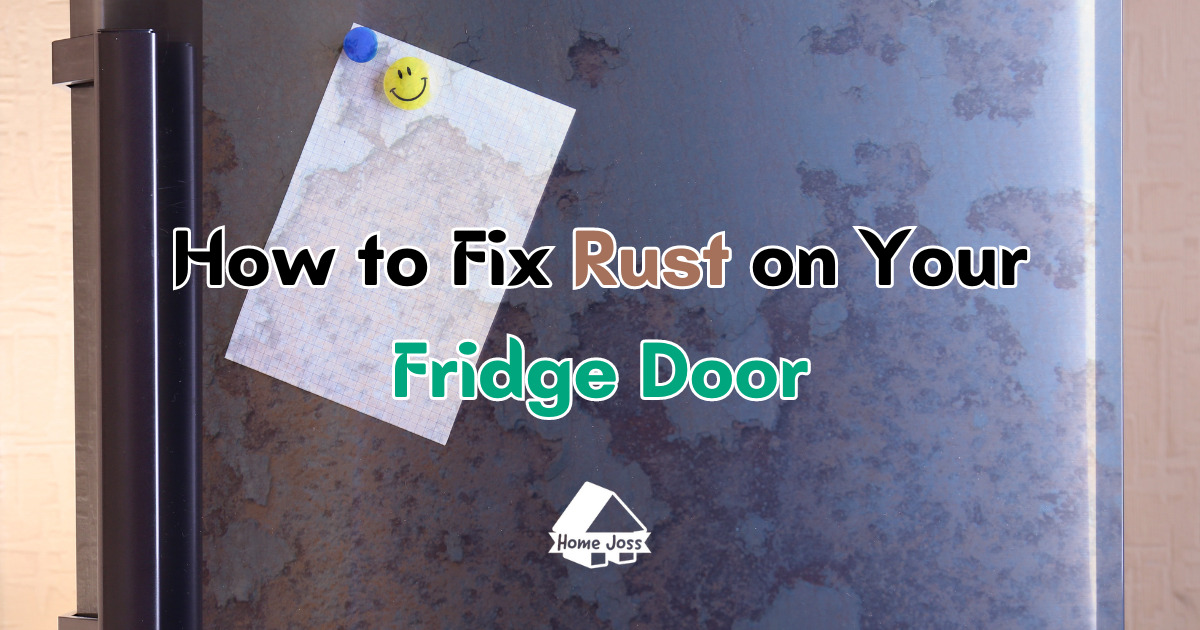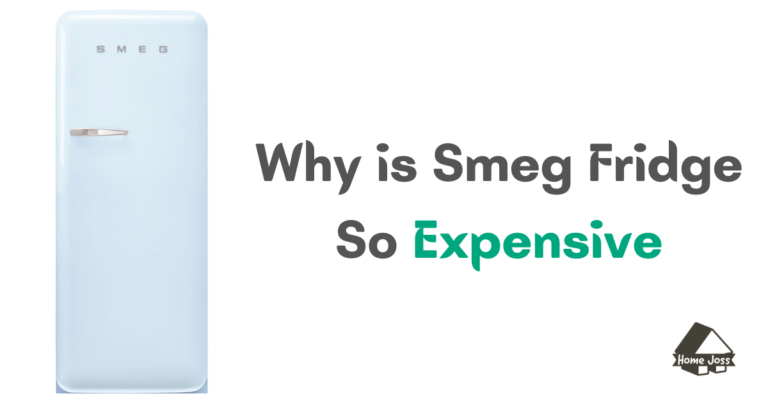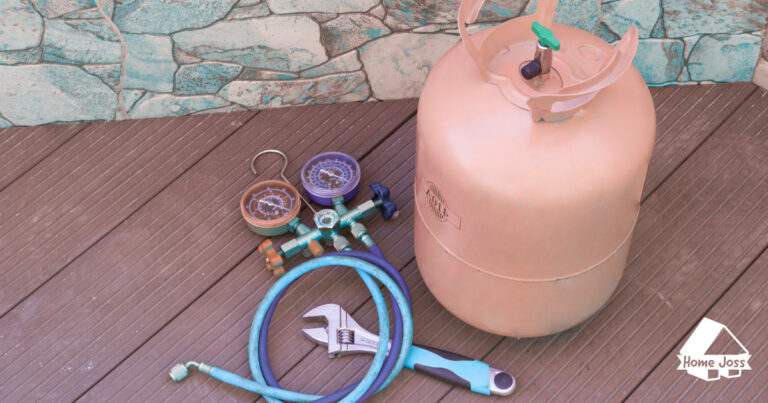As a fridge owner, you may have encountered the unsightly issue of rust on your refrigerator door. While it may be tempting to replace the entire unit, there are various cleaning methods that can help restore your fridge door to its original condition.
In this step-by-step guide, we will explore different techniques and products that can effectively remove rust and provide step-by-step instructions on how to fix rust on your fridge door.

Dealing with Fridge Door Rust
Rust on your refrigerator door can be an eyesore, but it doesn’t necessarily mean you need to replace the entire appliance. In many cases, the rust is localized and can be effectively removed with the right cleaning methods and products. Before diving into the solutions, it’s important to understand the causes of fridge door rust.
Fridge doors are typically made of stainless steel, which is known for its durability and resistance to corrosion. However, over time, factors such as moisture, exposure to air, and scratches can compromise the protective layer of the stainless steel, leading to the formation of rust.
It’s crucial to address rust as soon as it appears to prevent further damage and maintain the aesthetic appeal of your fridge.
Using Baking Soda to Remove Rust
Baking soda is a versatile cleaning agent that can also help remove rust from stainless steel surfaces, including your fridge door. Here’s a step-by-step guide on how to use baking soda to fix rust on your fridge door:
- Create a Baking Soda Paste: Dampen the surface of the refrigerator door and apply a thin layer of baking soda to the rusted area. You can either use pure baking soda or create a paste by mixing 1 tablespoon of baking soda with 2 cups of water.
- Allow the Paste to Set: Let the baking soda mixture sit on the rusted area for 30 minutes to an hour. This will give the baking soda enough time to work its magic and loosen the rust.
- Scrub the Rust Away: Grab a toothbrush or a soft bristle brush and start scrubbing the rusted area in circular motions. Apply gentle pressure and continue scrubbing until the rust is fully removed.
- Rinse and Dry: Once the rust is gone, rinse the area with water to remove any residue. Use a paper towel or a soft cloth to dry the surface of the fridge door.
Using baking soda is an effective and affordable way to remove rust from your fridge door. If you prefer an alternative method, you can also mix baking soda with lemon juice to create a paste.
Combine equal parts lemon juice and baking soda, apply the paste to the rusted area, and follow the same steps outlined above.
Try Oxalic Acid Rust Remover
If baking soda doesn’t fully remove the rust from your fridge door, you can try using a rust remover that contains oxalic acid. Here’s how to use an oxalic acid rust remover to fix rust on your fridge door:
- Choose a Recommended Product: Look for rust removers that contain oxalic acid, such as Bar Keeper’s Friend Soft Cleanser, Kleen King Stainless Steel and Copper Cleaner, or Revere Ware Copper and Stainless Steel Cleaner/Polish. These products can be found at most home improvement stores.
- Rub the Cleanser: Dampen a soft sponge and apply the rust remover in the same direction as the grain of the metal. Rub the stain until it is completely gone.
- Rinse and Dry: Wash off the rust remover with water and use a towel to dry the surface of the fridge door. Avoid using caustic cleaners that contain chlorides, as they can be too abrasive and may damage the protective layer of the stainless steel.
Using an oxalic acid rust remover can be an effective solution for stubborn rust stains on your fridge door. Make sure to follow the instructions provided by the manufacturer and take necessary safety precautions.
Power of Vinegar
Vinegar is a household staple that can also be used as a natural rust remover. Here’s how you can harness the power of vinegar to fix rust on your fridge door:
- Apply Vinegar: Pour a liberal amount of vinegar onto a soft sponge or rag. Use the sponge to rub the rusted area, applying gentle pressure until the stain starts to lift. Repeat if necessary.
- Consider Cleaning Vinegar: Cleaning vinegar, which has a higher acidity level than regular vinegar, can be especially effective for removing rust from stainless steel. It typically has around 6 percent acidity compared to the 5 percent acidity of regular vinegar. To use cleaning vinegar, pour a few tablespoons directly onto a microfiber cloth and rub the rusted area in the direction of the grain.
- Wipe and Dry: After removing the rust, wipe the surface of the fridge door with a clean microfiber cloth to remove any vinegar residue. This will help prevent any potential damage to the stainless steel.
Vinegar is a natural and cost-effective rust remover that can be easily found in most households. However, keep in mind that vinegar is acidic, so it’s essential to test it on a small, inconspicuous area of your fridge door before applying it to the entire surface.
Preventive Measures to Avoid Rust
Once you have successfully removed the rust from your fridge door, it’s important to take preventive measures to avoid future rust formation. Here are some tips to help you protect your fridge door from rust:
- Regular Cleaning: Clean your fridge door regularly to remove any dirt, grime, or moisture that may contribute to rust formation. Use mild soap and water, or a stainless steel cleaner specifically designed for appliances.
- Avoid Abrasive Cleaners: Stay away from abrasive cleaners and steel wool, as they can scratch the protective layer of the stainless steel and make it more susceptible to rust.
- Promptly Wipe Spills: If any liquid spills on your fridge door, wipe it up promptly to prevent prolonged exposure to moisture.
- Apply Protective Coating: Consider applying a protective coating or wax designed for stainless steel appliances. This can help create an additional barrier against moisture and minimize the risk of rust formation.
Taking these preventive measures can significantly reduce the likelihood of rust appearing on your fridge door and help keep it looking clean and pristine for years to come.
Using Rust-oleum Epoxy Appliance Paint
If the rust on your fridge door is extensive or the previous methods haven’t provided satisfactory results, you may consider using rust-oleum epoxy appliance paint to fix the issue. Here’s how to use this specialized paint to restore your fridge door:
- Prepare the Surface: Start by removing any loose rust or paint from the affected area. Use a pocket knife or a scraper to gently scrape away the rust until you reach a solid paint surface.
- Mask Off the Area: To protect the surrounding surfaces, use blue masking tape to create a barrier around the rusted area. Leave a small section of the solid paint exposed for blending purposes.
- Apply the Paint: Follow the instructions provided by the rust-oleum epoxy appliance paint. Apply a thin, even coat over the rusted area, making sure to blend it with the surrounding paint to create a seamless finish. Allow the paint to dry according to the manufacturer’s recommendations.
- Sand and Repeat: Once the paint is dry, use fine-grit sandpaper (around 220 grit) to smooth out any imperfections and blend the edges of the painted area. Apply a second coat of paint if necessary, following the same steps as before.
- Seal and Reassemble: If you suspect that water leakage caused the rust, consider sealing the area with silicone to prevent future moisture penetration. Finally, reassemble any removed parts, such as moldings or trays, and admire your newly restored fridge door.
Using rust-oleum epoxy appliance paint can be an effective solution for more severe rust damage. However, it’s important to carefully read and follow the instructions provided by the manufacturer to achieve the best results.
Professional Rust Removal Services
For extensive or stubborn rust on your fridge door that cannot be resolved with DIY methods, you may want to consider professional rust removal services. Rust removal professionals have the expertise and specialized equipment to effectively treat and restore stainless steel surfaces.
They can assess the extent of the rust damage and recommend the most suitable course of action. If you decide to hire a professional, make sure to do thorough research, read reviews, and choose a reputable service provider.
Additional Tips and Tricks
Here are some additional tips and tricks to help you tackle rust on your fridge door:
- Use Lemon Juice and Salt: Create a paste by mixing lemon juice and salt, then apply it to the rusted area. Let it sit for a few hours before scrubbing it off with a soft brush or sponge.
- Try WD-40: WD-40, a multipurpose lubricant, can also be effective in removing rust from stainless steel surfaces. Apply a small amount to the rusted area, let it sit for several minutes, then scrub it off with a soft brush or sponge.
- Consider Stainless Steel Cleaners: There are numerous stainless steel cleaners available on the market specifically designed to remove rust and restore the shine of stainless steel surfaces. Follow the instructions provided by the manufacturer for the best results.
- Regular Maintenance: Incorporate regular maintenance into your cleaning routine. Inspect your fridge door for any signs of rust or damage and address them promptly to prevent further deterioration.
Remember to always test any cleaning product or method on a small, inconspicuous area before applying it to the entire surface of your fridge door.
FAQ about How to Fix Rust on Your Fridge Door
Can I use vinegar to remove rust from a painted fridge door?
Yes, vinegar can be used to remove rust from a painted fridge door. However, be cautious when applying vinegar to painted surfaces, as it may cause damage or discoloration. Test it on a small, hidden area before proceeding.
How often should I clean my fridge door to prevent rust?
It is recommended to clean your fridge door at least once a week to remove any dirt, grime, or moisture that may contribute to rust formation.
Can I use steel wool to remove rust from my fridge door?
It is not recommended to use steel wool on stainless steel surfaces, as it can scratch and damage the protective layer. Opt for softer brushes or sponges instead.
How can I prevent rust from reoccurring on my fridge door?
Regular cleaning, avoiding abrasive cleaners, promptly wiping spills, and applying a protective coating or wax are effective preventive measures to avoid rust formation on your fridge door.
Can a professional rust removal service fix severe rust damage?
Yes, professional rust removal services have the expertise and equipment to handle severe rust damage. They can assess the situation and provide appropriate solutions tailored to your specific needs.
Can I use baking soda and vinegar together to remove rust?
While baking soda and vinegar are both effective rust removers, it is not necessary to use them together. They can be used separately, depending on your preference and the severity of the rust.
Is it possible to repaint a fridge door to cover up rust?
Yes, it is possible to repaint a fridge door to cover up rust. Rust-oleum epoxy appliance paint is specifically designed for this purpose and can provide a durable and seamless finish.
How long does it take for rust-oleum epoxy appliance paint to dry?
The drying time for rust-oleum epoxy appliance paint can vary depending on the specific product. Follow the manufacturer’s instructions for recommended drying times.
Can I use lemon juice to remove rust from stainless steel?
Yes, lemon juice can be effective in removing rust from stainless steel surfaces. Its acidic properties help break down rust stains. Apply lemon juice to the rusted area, let it sit for a few hours, then scrub it off.
Is it possible to prevent rust on a fridge door entirely?
While it may not be possible to completely prevent rust, taking preventive measures such as regular cleaning, avoiding abrasive cleaners, and promptly addressing any rust or damage can significantly reduce the likelihood of rust formation.
Dealing with rust on your fridge door doesn’t have to be a cause for panic. By following the techniques and tips outlined in this comprehensive guide, you can effectively remove rust and restore your fridge door to its original condition.
Whether you choose to use baking soda, oxalic acid rust remover, vinegar, or specialized paint, always prioritize safety and carefully follow the instructions provided.
Remember to incorporate preventive measures into your routine to avoid future rust formation. With the right approach and regular maintenance, your fridge door can remain rust-free and maintain its aesthetic appeal for years to come.






